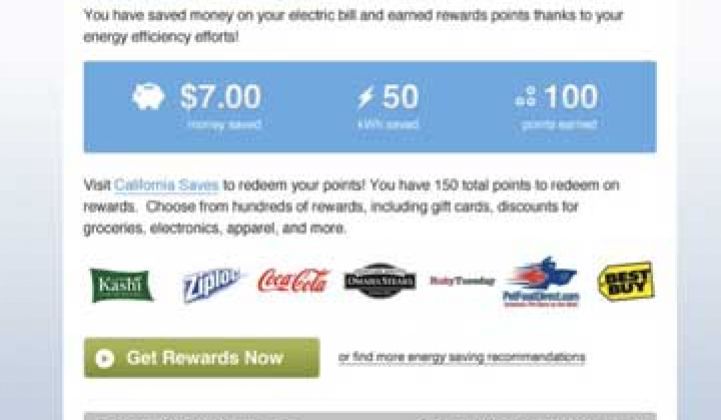There are two things people love in this world: getting discounts and helping their kids succeed. In the sphere of residential energy efficiency, these two ideas have been married by Efficiency 2.0, which offers a rewards program for homeowners who cut their energy use -- and in a few instances, Efficiency 2.0 is using schools to spread the word.
The New York City-based company’s Personal Energy Efficiency Rewards Program, or PEER, is involved in about half a dozen pilots, the largest of which is with Commonwealth Edison in Chicago. There is a two-pronged approach of sending out mailings with advice about how you compare to your neighbors and simple ways to cut energy use, along with a more involved website that people can opt in to to earn coupons.
“We’re taking a radically different approach,” said Tom Scaramellino, Founder and CEO of Efficiency 2.0. And yet, the basics of the program are well-worn territories in other green consumer programs. If sending out mailings sounds familiar, it is. OPower is the best-known example, but other companies also use email and snail mail to let people know how they’re doing on energy efficiency. Efficiency 2.0 currently sends out printed reports to more than 300,000 people.
From there, customers can sign up for a website where they can get even more tailored data and earn rewards. If earning rewards for green behavior also sounds familiar, it is. The company RecycleBank offers reward points when users save a certain amount of kilowatt hours. Currently, 50 kWh is worth a $10 coupon, according Scaramellino.
The average energy savings for the customers who have opted in to the web program averages about 6.1 percent compared to about 2.5 percent for those who just get the energy savings report in the mail. More than 12,000 people are signed up in the Chicago area.
The next step in all of this is competition. Scaramellino admitted the uptake wasn’t as good as hoped when they just sent the mass mailings through the utilities. But once they got schools involved, things really took off. “All of a sudden, parents drop what they’re doing,” he said. Instead of selling magazines to raise money, kids were pushing low-flow showerheads and CFLs. Schools in both Illinois and Massachusetts have tried the program.
Many of the actions people are taking are simple, and low- or no-cost, like replacing bulbs or drawing the blinds in summer. The company, however, also offers personalized recommendations that it claims are more accurate and robust than what nearly any other competitor is offering; they achieve this by crunching more than 500 million data points. “It’s like a Google crawl for energy,” said Scaramellino.
Integrating sophisticated analytics using weather, historical and other personal data into any home energy management offering is becoming more common. Google actually just got out of the utility business, folding its PowerMeter initiative because it didn't see the growth it had hoped for.
Collecting millions of data points and turning that into actionable information may be a competitive advantage today, but in the future, it will be mandatory to stay in the market.
Efficiency 2.0 gets novelty points in the HAN space for bringing in the coupon game. People love local involvement and coupons, which is part of RecycleBanks’ success (Chicago was also one of the first cities to adopt RecycleBank).
Utilities also like low-cost solutions, which is one of the reasons for OPower’s success and why Efficiency 2.0 has appeal to ComEd, Northeast Utilities, Cambridge Energy Alliance and others.
In the long run, a figure of six percent energy savings is superb for the utility, but could grow old with consumers if they see a diminishing return after they make initial changes. The PEER Program also offers suggestions for upgrades, which could spur more changes. Scaramellino thinks that it will be the competition aspect, via social media and through neighborhood programs, that will catch and keep people’s attention.
Efficiency 2.0 is hoping its point system will make it a major player in coming years. The short-term goal: gain five million online customers by 2014.



